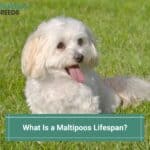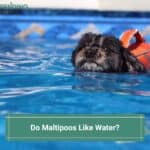
Determining whether your dog will get along with other dogs is undeniably one of the most crucial questions. Do Maltipoos get along with other dogs?
Luckily, Maltipoos generally have a good rapport with other dogs and can peacefully coexist with other pets.
Being a small breed, they are most compatible with dogs of similar size.
They are friendly animals, but they may experience separation anxiety, which can be alleviated by having a second dog as a companion.
Read on to learn more.
Before you scroll further down this guide, check out these other Maltipoo-related articles: Facts About the Brown and White Maltipoo Puppy and When Is A Maltipoo Full Grown?.
Table of Contents
About The Maltipoos

The Maltipoo is a delightful hybrid breed from crossing the Poodle and the Maltese.
Usually, the Toy or Miniature Poodle is used in the breeding process, resulting in a small-sized dog.
Poodles are renowned for their intelligence, happiness, loyalty, and active nature, making them excellent family pets.
On the other hand, Maltese dogs are known for their gentleness, cleverness, friendly demeanor, and role as great companions.
Poodles have a history as working water dogs, while Maltese dogs were bred as companions for the wealthy.
When you bring a Maltipoo into your home, you can expect a blend of the parent breeds’ temperaments. Your dog will be brilliant, friendly, playful, and ever-loyal.
Maltipoos have a keen sense of alertness and may enjoy barking at activities happening outdoors, making them excellent watchdogs.
While Maltipoos make fantastic family dogs, their small size makes them susceptible to injury, so it’s essential to supervise young children around them closely.
They averagely weigh between 4 and 25 lbs and stand at 6” to 15”. With their charming disposition and mixed traits, Maltipoos will bring joy and companionship to any home.
Maltipoos and Other Dogs
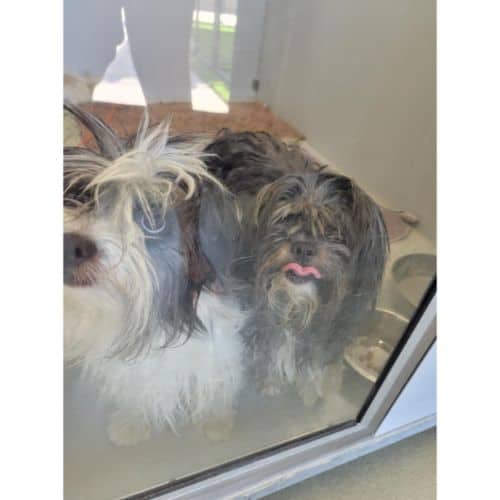
Generally, Maltipos get along well with other dogs, but their small size requires some consideration when introducing them to larger dogs.
If you already have a giant dog, it’s crucial to be mindful of the size difference to avoid potential injuries to your Maltipoo.
While dogs of all sizes enjoy play-fighting, it’s ideal to have dogs of similar sizes for safer and more enjoyable interactions.
Introducing two new dogs should be a gradual and patient process. Simply putting two unfamiliar dogs in a room together can be risky.
Instead, it requires careful planning, adult supervision, and positive reinforcement through praise and rewards.
Start with short periods together and gradually increase the duration.
Also, ensure that no dogs feel left out during this adjustment phase by focusing on each to help them adapt to the new situation.
With time and patience, your Maltipoo can build positive relationships with other dogs and pets, enriching their social life and overall well-being.
How Do You Socialize a Maltipoo?
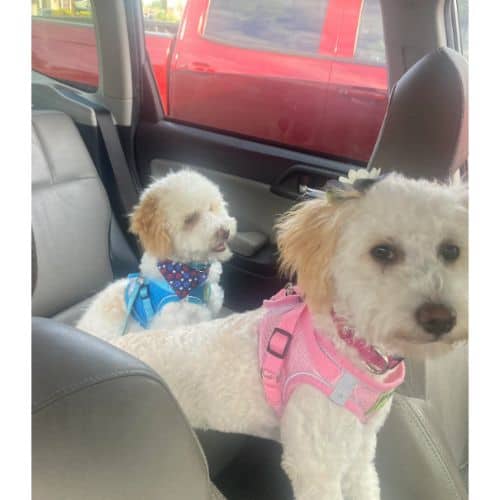
Maltipoos are genuinely captivating and wholehearted dogs, blessed with charming and easygoing personalities that endear them to their owners.
Their lovable nature makes them a perfect match for the proper household. Maltipoos flourish in families that have other pets and children.
However, they still need socialization and proper training to have a good time with the family and other dogs. Here is how you can do it:
Keep a Slow Pace
One common mistake that dog owners often make is rushing to integrate their new Maltipoo into their existing family of pets.
While the intention behind this is good, it’s essential to remember that the Maltipoo is still adjusting to its new home, including unfamiliar scents, sounds, and surroundings.
For a smooth transition, it’s best to avoid immediately thrusting them into a situation with other pets, especially considering their age and history.
Instead, try keeping the Maltipoo in a separate room for about a week. That allows them to acclimate to the environment before gradually introducing them to the other pets.
Starting the integration process immediately can lead to potential aggression or nervousness.
However, if your Maltipoo has been in the house for a while, it’s alright to begin the integration process promptly, as they would have likely adapted to the new setting.
Remember to take it slowly and carefully to ensure a harmonious, stress-free relationship between your Maltipoo and other dogs.
Ensure Comfort
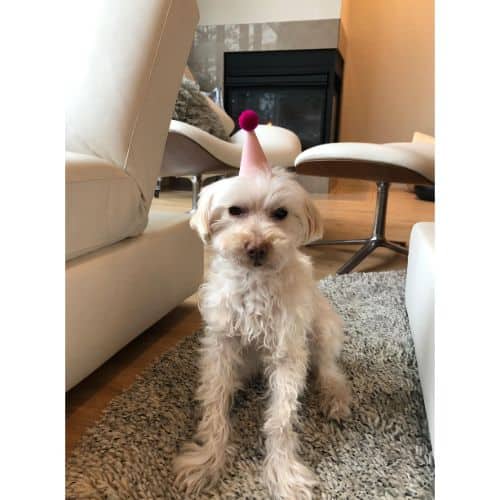
Maltipoos find joy in the little comforts of their daily lives, such as a cozy dog bed or a favorite spot to sit during the day.
When introducing them to other pets, beginning in a setting where they feel the most at ease is essential.
Familiar surroundings can help them feel more comfortable while welcoming other pets into their space.
While this approach may not always guarantee immediate success, there might be moments when your Maltipoo displays signs of nervousness, which is perfectly normal.
Observe the interaction closely and stay nearby to provide reassurance and support.
With patience and gradual introductions, your Maltipoo will have the opportunity to build positive relationships with other pets over time.
Be Incharge
Socializing Maltipoos with other pets is a gradual process that requires continuous effort from the dog owner.
To maintain control during the initial interactions, consider the following steps:
Use a pet gate
Utilize a pet gate to create a safe barrier between your Maltipoo and the other pets.
That allows for controlled observation and prevents direct contact.
Use a leash
Keep your Maltipoo on a dog leash during interactions. That gives you better control over their movements and ensures a safe environment.
Supervise all interactions
Be present and attentive during the interactions between your Maltipoo and other pets. Supervision is crucial to identify any signs of aggression or discomfort.
As a responsible dog owner, your primary goal is to retain control while observing how the pets interact.
You can gradually loosen the restrictions if the initial interactions seem positive and without any aggression.
For example, during the interaction, start with your Maltipoo on a dog leash and behind the pet gate.
If there are no signs of aggression, you may remove the pet gate while keeping the dog on the leash.
Continue reducing the restrictions as long as the pets get along well.
Use Treats As Rewards
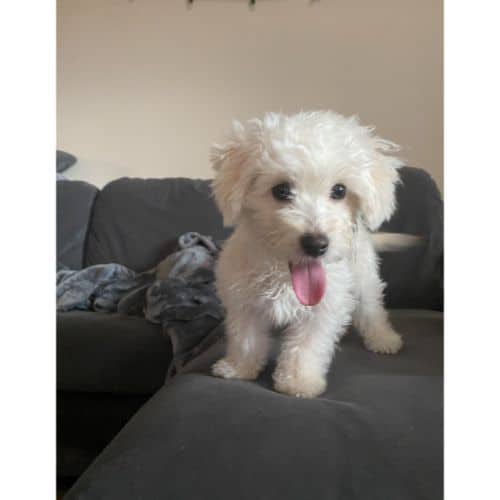
The most effective approach to socializing a dog with other pets is positive reinforcement for good behavior, particularly refraining from aggressive actions.
This method boosts the dog’s confidence and helps alleviate its nervousness.
Maltipoos respond well to dog treats as a positive reinforcement tool. Using these treats during their interactions with other pets can yield favorable results.
For instance, when your Maltipoo enters a room with another pet and behaves well, remaining gentle and calm, you can reward them with a dog treat.
Conversely, if they display undesirable behavior, withhold the treat and provide a quick, sharp “No” to help them understand their mistake.
Initially, Maltipoos may not immediately connect the reward with good behavior, but they are intelligent dogs and will grasp the concept after a few attempts.
Additionally, dog treats are not the only options for positive reinforcement.
A simple rub behind the ears or a scratch under the chin can also convey approval and let the Maltipoo know they are doing well.
By consistently using positive reinforcement, you can foster positive associations with interactions with other pets, aiding in successful socialization for your Maltipoo.
Do Not Overreact
It’s not uncommon for Maltipoo owners to feel concerned during new interactions with other pets.
There’s a natural anticipation of potential aggression, and the instinct to stop it immediately is strong.
While addressing aggression promptly is essential, overreacting can lead to unintended consequences.
An excessive reaction may cause the Maltipoo to become fearful and withdraw into a protective bubble, making it challenging to foster positive interactions with other pets.
As a responsible dog owner, remaining confident and assertive is crucial.
When your Maltipoo misbehaves, address the behavior firmly without resorting to aggression or harsh actions, such as yanking on the dog leash if one is being used.
Remember that dogs pick up on your reactions; even well-intentioned aggression can be misinterpreted by your Maltipoo.
Instead, stay composed and go through the socialization process again calmly.
Work persistently on the interactions until your Maltipoo and other pets harmonize. Patience, consistency, and a calm demeanor will lead to successful socialization.
Consider Dog Parks

The dog park offers a delightful opportunity to socialize with your Maltipoo.
Once your dog has grown accustomed to other pets at home, it’s time to expand their social bubble and observe how they interact in different environments.
If you have another dog, consider taking both of them together. This familiar presence will comfort your Maltipoo as they interact with other dogs and people.
The ultimate goal is to expose them to various unique interactions without hesitation.
That can involve encounters with other pets, animals, people, traffic, loud sounds, and various stimuli.
Gradually introducing them to diverse environments will contribute to their overall socialization and make for a well-adjusted and confident Maltipoo.
FAQs About Maltipoos
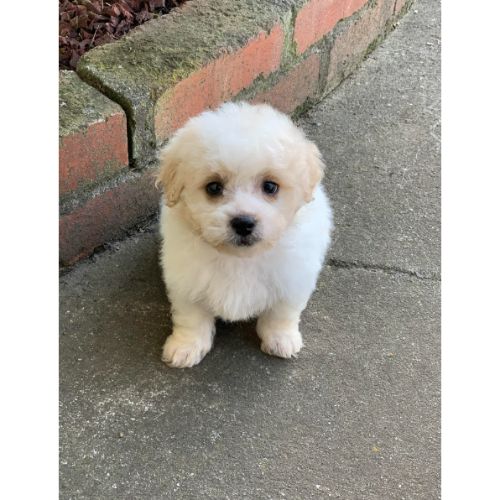
Why is my Maltipoo aggressive towards other dogs?
Lack of socialization
Dogs not adequately socialized during their early development stages may feel fear or discomfort around other dogs.
Early positive experiences with other dogs and different environments can help dogs become more confident and relaxed when interacting with other canines.
Fear or anxiety
Aggression can be a defensive response to a perceived threat. If your Maltipoo is fearful or anxious around other dogs, they may use aggression to protect themselves.
Territorial behavior
Some dogs can become aggressive towards other dogs when they feel their home or personal space is invaded.
Resource guarding
If your Maltipoo possesses toys, food, or other items, they might become aggressive when other dogs approach these resources.
Improper training
Dogs need consistent training and boundaries to learn appropriate behavior around other dogs. With proper guidance, they may understand how to interact peacefully.
Past bad experiences
Past negative encounters with other dogs, such as fights or attacks, can lead to future fear or aggression toward dogs.
Medical issues
Sometimes, aggression can be linked to underlying health problems. Pain or discomfort could trigger aggressive behavior.
Genetic predisposition
Certain dog breeds or mixes may have a genetic predisposition towards certain behaviors, including aggression.
What are the behavior issues with Maltipoos?
Like all dog breeds, Maltipoos can exhibit various behavior issues, but it’s important to remember that individual dogs may differ in their behavior due to their unique personalities and experiences.
Here are some expected behavior issues that Maltipoos may experience:
Separation anxiety
Maltipoos are known for forming strong attachments with their owners, and they may become anxious or distressed when left alone for extended periods.
That can lead to destructive behavior, excessive barking, or inappropriate toileting.
Fear and shyness
Some Maltipoos may be naturally more reserved or fearful, especially if they haven’t been adequately socialized during their early developmental stages.
Proper socialization can help reduce fear-based behavior.
Aggression
Aggression towards other dogs or people can sometimes be an issue, particularly if a Maltipoo feels threatened or has negative past experiences.
Excessive barking
Maltipoos are known to be vocal dogs, and they may bark excessively if they are bored, anxious, or trying to get attention.
Leash reactivity
Some Maltipoos may react strongly on the leash when encountering other dogs or stimuli, pulling, lunging, or barking.
House-training difficulties
Some Malitpoos might have challenges with potty training, especially if consistency and positive reinforcement are lacking.
Jumping and hyperactivity
Maltipoos can be energetic and excitable, leading to jumping on people or becoming overly hyper.
Early and consistent training, positive reinforcement, and proper socialization are essential to prevent or address behavior issues with your Maltipoo.
Do Maltipoos Get Along With Other Dogs?
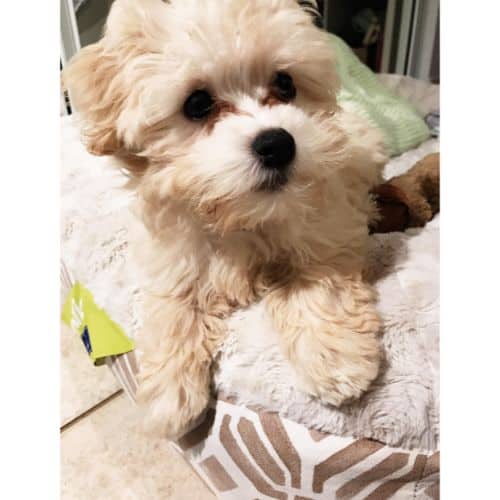
Ensuring that your Maltipoo gets along with other dogs is critical, particularly if you already have pets or are looking for a well-behaved companion.
Fortunately, Maltipoos generally have a good rapport with other dogs and can coexist peacefully, especially when introduced gradually and with adult supervision.
Socializing your Maltipoo with other pets requires patience, positive reinforcement, and a calm demeanor to build positive associations and confidence.
Addressing potential aggressive behavior or fear through pepper training and socialization is critical to fostering harmonious interactions.
By understanding the breed’s tendencies and investing time in socialization, your Maltipoo can become a joyful and well-adjusted addition to your family and enrich your home with companionship and love.
If you find this guide, “Do Maltipoos Get Along With Other Dogs,” informative and helpful, you can check out these other Maltipoo-related articles from our team:
- Maltipoo Puppies in California – Top Breeders
- Do Maltipoos Like Water?
- Maltipoo For Adoption – Top Rescues In The USA
You can learn more about Maltipoo dog breed, by watching “Maltipoo: Everything You Need To Know – Is It the Right Dog for You? | Maltese Poodle Mix” down below:

